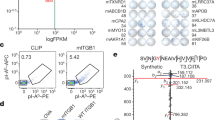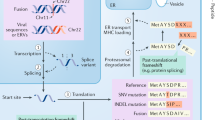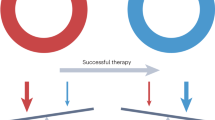Abstract
Tumours induced by physical or chemical carcinogens often express tumour-specific antigens that can induce strong protective immune defence in the host. The diversity of these unique antigens among different tumours is seemingly endless, and has been compared to that of immune receptors1. At present, the nature and complexity of this antigenicity is not known for any single tumour. Here we describe the unique antigenicity expressed by a murine ultraviolet light (UV)-induced fibrosarcoma. This tumour is clearly subject to immune surveillance by the normal host2, and does not grow progressively unless it undergoes antigenic changes3. Using defined monoclonal T-cell probes and tumour variants selected in vitro with these probes, we found that the total antigenicity consisted of multiple independent components, all of which were tumour-specific and expressed simultaneously on the same tumour cell. The demonstration of this antigenic complexity will enable us to identify and compare the molecular composition of the components of this antigen, as well as to determine their individual roles in tumour rejection and escape.
This is a preview of subscription content, access via your institution
Access options
Subscribe to this journal
Receive 51 print issues and online access
$199.00 per year
only $3.90 per issue
Buy this article
- Purchase on Springer Link
- Instant access to full article PDF
Prices may be subject to local taxes which are calculated during checkout
Similar content being viewed by others
References
Burnet, F. M. Nature 226, 123–126 (1970).
Kripke, M. L. Adv. Cancer Res. 34, 69–106 (1981).
Urban, J. L., Burton, R. C., Holland, J. M., Kripke, M. L. & Schreiber, H. J. exp. Med. 155, 557–573 (1982).
Kripke, M. L. Cancer Res. 37, 1395–1399 (1977).
Flood, P. M., Kripke, M. L., Rowley, D. A. & Schreiber, H. Proc. natn. Acad. Sci. U.S.A. 77, 2209–2213 (1980).
Flood, P. M., Urban, J. L., Kripke, M. L. & Schreiber, H. J. exp. Med. 154, 275–290 (1981).
Epstein, S. L., Ozato, K. & Sachs, D. H. J. Immun. 125, 129–135 (1980).
Maryanski, J. L. & Boon, T. Eur. J. Immun. 12, 406–412 (1982).
Borst, P. & Cross, G. A. M. Cell 29, 291–303 (1982).
Wortzel, R. D., Urban, J. L., Philipps, C., Fitch, F. W. & Schreiber, H. J. Immun. 130, 2461–2466 (1983).
Glasebrook, A. L. & Fitch, F. W. J. exp. Med. 151, 876–895 (1980).
Author information
Authors and Affiliations
Rights and permissions
About this article
Cite this article
Wortzel, R., Philipps, C. & Schreiber, H. Multiple tumour-specific antigens expressed on a single tumour cell. Nature 304, 165–167 (1983). https://doi.org/10.1038/304165a0
Received:
Accepted:
Issue Date:
DOI: https://doi.org/10.1038/304165a0
This article is cited by
-
Trends and advances in tumor immunology and lung cancer immunotherapy
Journal of Experimental & Clinical Cancer Research (2016)
-
Immunotherapy for breast cancer: past, present, and future
Cancer and Metastasis Reviews (2016)
-
In silico proteomic characterization of human epidermal growth factor receptor 2 (HER-2) for the mapping of high affinity antigenic determinants against breast cancer
Amino Acids (2012)
-
Regulation of the innate and adaptive immune responses by Stat-3 signaling in tumor cells
Nature Medicine (2004)
-
Clinical significance of immune cell infiltration within gallbladder cancer
British Journal of Cancer (2003)
Comments
By submitting a comment you agree to abide by our Terms and Community Guidelines. If you find something abusive or that does not comply with our terms or guidelines please flag it as inappropriate.



